Guest post: Uri Yerushalmi
The new “Collective Intelligence”
Originally, the term “Collective Intelligence” referred to a shared intelligence that emerges from collaboration or competition of many entities in the context of political science or sociobiology. But the same concept can be used to describe a new revolution, where the combination of recent AI technologies with the potential of decentralized ecosystems is expected to change the landscape of AI economy.
In the below we will mention several characteristics of AI economy, currently “pushing” the ecosystem to grow centralized tech giants, and how new types of blockchain-based architectures can “flip” the same attributes to push for massive decentralization:
AI Economy Qualities
Quality #1: The more resources, the more valuable your service
Currently, in order to solve extremely difficult problems, an individual needs control over huge teams and massive amounts of data. The only entities that have this ability are what we now call the “Tech Giants.” Unfortunately, smaller entities cannot meaningfully contribute to solving highly complex problems (unless a Tech Giant eventually purchases the entity). Therefore, even if Tech Giants didn’t exist, somebody would have needed to create them eventually.

“Flipping” potential: With the ability to have trustless relationships based on the blockchain, an individual does not need full ownership nor full control over huge teams nor massive amounts of data. Instead, ad hoc communities can rise to solve specific problems, controlled by smart contracts, and as more entities join in–the more valuable the service provided by the community.
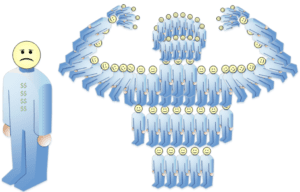
Quality #2: The loopback advantage in AI business models
Let’s compare two competitors providing an AI-based service: Alice and Bob, where Alice’s model is superior, but Bob’s business model is slightly different. Bob gets feedback for every prediction he gives and the accuracy of the prediction. It’s clear that, in spite of the initial supremacy of Alice’s service, Bob is going to win since the loopback advantage provides an infinite chance to improve his model. This structure creates a situation where Tech Giants, who have substantially more data flow, tend to control their own loopbacks and therefore get eventually better models.

“Flipping” potential: Given the right infrastructure, Alice can collaborate with Eve, who controls the feedback data-flow, and, together, they can beat Bob.
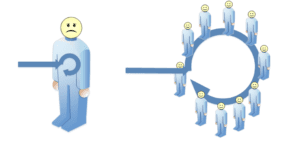
Quality #3: Trusting small Black Box providers
AI models, unlike traditional software systems, tend to work as black boxes, being that it is very difficult to define or understand the internal logic of the model. (See restaurants example here.) Such a trend might create a phenomenon where several giant providers dominate because of their reputation to provide good services.
“Flipping” potential: Given the immutability of predictions written on the blockchain, reputation of AI providers would not be dependent on their size, which should raise the demand for high quality small AI providers.
Quality #4: Data Sensitivity
More people are now aware of the fact that data is sensitive, and still we usually choose to continue sharing our data (in spite of huge scandals) with Tech Giants and not with small entities just because we tend to trust tech giants more. But various new encryption methods present a “Flipping” potential, where the tech giants lose their size-dependent trust advantage.
Quality #5: Transferable Models
In modern AI, models that were optimized to achieve a certain goal are very useful for achieving very different ones. Therefore, entities that possess knowledge about a large variety of AI models would tend to have advantage building new ones. However, a “flipping” potential would occur when there is a marketplace for transferable models, something blockchain technology is well suited to enable.
Architectural Solutions
The following architectures can be enhanced by blockchain technology and “flip” the outcome of the economic forces above from being “centralizing” to “decentralizing.” All following architectures are based on smart contract mechanisms like the processing engine developed by Dopamine.ai using the Solidity language. Such an engine can easily be run on Hyperledger Burrow, one of the Hyperledger projects hosted by the Linux Foundation. Burrow provides a modular blockchain client with a permissioned smart contract interpreter partially developed to the specification of the Ethereum Virtual Machine (EVM).
Crowd Teaching
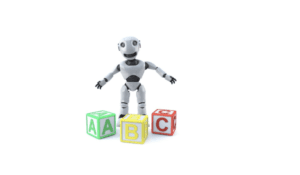
As a small entity that does not have the data to train a model, why not ask others to train your model and, in return, get rewarded? The reward can be in FIAT, tokens or even equity of the model. Rewards can be based on contribution of the “teacher” to the teaching quality. See an example here.
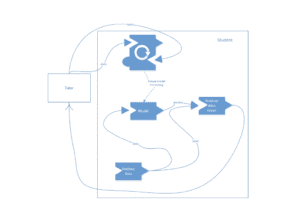
Transferring Models
For entities looking to develop an AI capability that has not been developed before, the best option may tapping similar models that can be adapted.: Why would one build the capability from scratch if someone else can provide a starting model in exchange for a reward? See example here.
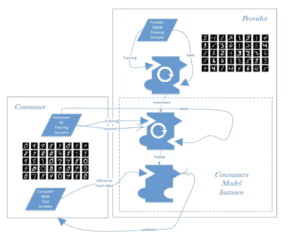
Hybrid Decentralized AI
As AI architectures get more and more complex, every sub-architecture needs its own expertise and know how. This need begs the questions, why not “mix and match” architectures from different providers, based on predefined smart contracts? See an example here.
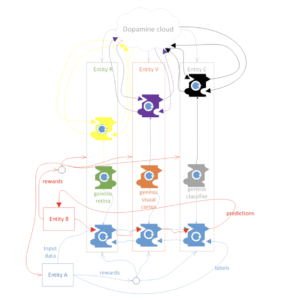
Tokenized AI
In many of the examples provided, there can be a massive number of contributors to a certain AI service. The best way to create a network effect and encourage the contributors to make the service succeed is to give them ownership. The end result would be an ecosystem with a massive amount of AI services that are actually mini-businesses, each with its own community of equity holders.
Privacy Techniques
Various privacy techniques are available for allowing collaboration while keeping data secure and private: Federated Learning, Differential Privacy, Multi-Party Computation, Homomorphic Encryption.
Reputation Techniques
When using an AI service, users generally make sure that the service has high standards and availability. Blockchain gives us two main techniques for a high quality reputation system:
- Curation & Staking – In a blockchain model, the curators and stakers are responsible for having a high quality list of providers, meaning any breakage of the providers‘ reputation would have a direct economic effect on the curators & stakers.
- Immutable Activity Logs – Unlike current ecosystem, where customers based their confidence in the accuracy of information on the brand of service provider, the blockchain era introduces a variety of tools that reveal accuracy based on immutable logging of services. For example: A financial company predicting that the price of Bitcoin would get to a certain value in a given date and would not be able to deny or “hide” it’s prediction .
Conditional Pricing
Today when consuming AI services (assuming we’ve decided not to build the solution in-house), we do not have many tools to estimate the quality of a given AI service provider. However blockchain opens the door to many types of AI deals where the payment is conditional. (Consumer pays AI service provider if provider was right, but, if provider was wrong,maybe consumer should get paid?).
Conclusion
We have seen above the possible effect of the combination of AI and blockchain on corporate structure in global economy. In such a view, technology corporations would have less of a size advantage and be more focused on the quality of technological services and less on product and brand name promotion. The market would be more competitive and less dependent on tech giants. Technological and AI expertise would be much more granular. Most importantly, the quality and variety of AI-based products would be much higher, with every such product backed by a whole community of entities instead of a single tech giant. We should expect a wave of new enablers, like Dopamine.ai, enabling this drastic ecosystem change.
Sign up for Hyperledger Horizon & /dev/weekly newsletters
By signing up, you acknowledge that your information is subject to The Linux Foundation's Privacy Policy